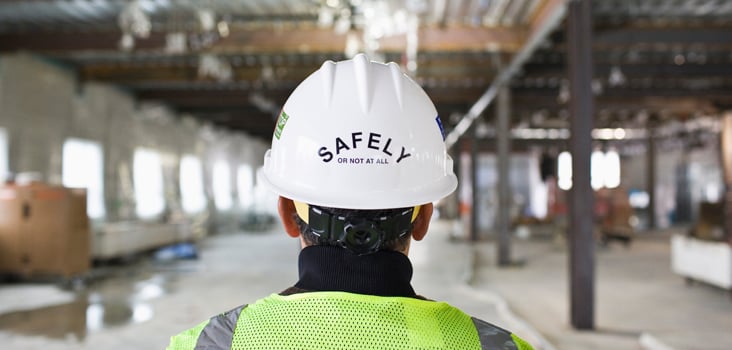
The Most Common Construction Injuries and How to Avoid Them
There are potential dangers in any industry, but the risks lurking in construction can lead to serious injuries, or even death.
The Occupational Safety and Health Administration (OSHA) has regulations in place to keep construction workers safe, but accidents still happen, specifically in four areas referred to as the “Fatal Four” by OSHA. These “Fatal Four” – falls, struck by object, electrocution, and caught-in/between – were responsible for more than half of all construction worker deaths in 2016.
By following OSHA regulations and designing the workplace and work processes for safety, construction companies can reduce the risk for the “Fatal Four” and save an estimated 602 workers’ lives in America every year.
Here’s what you need to know about the “Fatal Four” and how you can reduce the risk of your workers getting injured.
Falls
Falls can be split into two categories: falls from heights, which are the leading cause of fatalities in construction, and falls on the same level (a.k.a. slips and trips), which are one of the leading causes of injuries. Fall hazards are unfortunately just part of the territory on a construction site, with floor and roof openings, surfaces without strong support structures, and a reliance on scaffolds and ladders.
A long-term study completed between 1992 and 2005 found that about 33% of fatal falls in construction were from roofs, 18% were from scaffolding, and 16% were from ladders. A common contributing factor to these falls included unprotected edges of elevated work surfaces, including roofs, scaffolds, and ladders.
There are several things employers can do to prevent falls, including:
- Use appropriate fall protection equipment, like guardrail systems, safety net systems, and personal fall arrest systems
- Keep work areas well lit
- Maintain clear, tidy work areas free of clutter
- Ensure workers are wearing proper footwear with good traction
- Follow safety regulations for ladders, scaffolds, and roofs
- Train employees on appropriate regulations and safety measures
Struck by Object
The term “struck by” is defined by OSHA as injuries produced by forcible contact (like a tool falling from a higher level) or impact between the injured person and an object or piece of equipment (like being hit by a car).
Most struck by injuries can be avoided by wearing the appropriate personal protective equipment, like hardhats and safety glasses, and by staying alert and aware of surroundings.
Here are a few tips that employees can follow to prevent struck by injuries:
- Never position yourself between moving and fixed objects
- Stack materials properly to prevent sliding or falling
- Stay clear of lifted or suspended loads
- Secure tools and materials so they will not fall on those below
- Don’t drive a vehicle in reverse gear if your rear view is obstructed (unless you’re signaled that it’s safe)
- Wear the appropriate personal protective equipment to cover your eyes, face, and head
Electrocution
While electrocution can cause serious injuries like nerve damage, muscular contractions, and cardiac arrest, burns are the most common shock-related injury. These injuries tend to result from unsafe equipment or installation, an unsafe environment, or unsafe work practices.
OSHA’s regulations for electrical hazards focus on the design and use of electrical equipment and systems, covering requirements for construction and installation. Proper insulation, guarding, electrical protective devices, and safe work practices can help prevent electrocution injuries.
Employees who work directly with electrical equipment should follow some basic safety protocols, including:
- Use the required personal protective equipment
- Deenergize the equipment
- Use lockout and tag procedures to ensure that the equipment remain deenergized
- Use insulating protective equipment
- Maintain a safe distance from energized parts
Caught-In/Between
This is another gruesome risk when working on a site filled with heavy equipment and machinery. Caught-in/between accidents happen when a worker’s body is caught, crushed, squeezed, compressed, or pinched between two or more objects. This can happen if materials collapse onto someone, a vehicle traps someone against a wall, or a body part gets pulled into machinery.
The best way to avoid these injuries is to stay aware of surroundings and follow proper guarding guidelines for equipment. Employees should never:
- Place themselves between a piece of heavy equipment and an immovable object
- Work in the swing radius of rotating equipment
- Place their hands or body parts near moving parts
- Work inside an excavation where water is accumulating
- Wear gloves, long sleeve shirts, or jewelry around moving parts
Training your employees to follow safe procedures and work processes is your best bet for preventing on-the-job injuries. But when accidents do occur, having a proactively developed injury care plan ensures expert, timely care for injured workers. That means a faster claims process, and a faster (and fuller) return to work for your employee.
Concentra has spent nearly 40 years getting America's workforce back to work, and we can help you develop an effective injury care process to keep your workers safe and healthy. Talk to one of our injury care experts to learn more.



